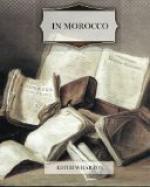Those who have walked around the outer walls of the mosque of the other Kairouan, and recall the successive doors opening into the forecourt and into the mosque itself, will be able to guess at the plan of the church of Fez. The great Almohad sanctuary of Tunisia is singularly free from parasitic buildings, and may be approached as easily as that of Cordova, but the approaches of El Kairouiyin are so built up that one never knows at which turn of the labyrinth one may catch sight of its court of fountains, or peep down the endless colonnades of which the Arabs say: “The man who should try to count the columns of Kairouiyin would go mad.”
Marble floors, heavy whitewashed piers, prostrate figures in the penumbra, rows of yellow slippers outside in the sunlight—out of such glimpses one must reconstruct a vision of the long vistas of arches, the blues and golds of the mirhab,[A] the lustre of bronze chandeliers, and the ivory inlaying of the twelfth-century minbar[B] of ebony and sandalwood.
[Footnote A: Niche in the sanctuary of mosques.]
[Footnote B: Movable pulpit.]
No Christian footstep has yet profaned Kairouiyin, but fairly definite information as to its plan has been gleaned by students of Moroccan art. The number of its “countless” columns has been counted, and it is known that, to the right of the mirhab, carved cedar doors open into a mortuary chapel called “the mosque of the dead”—and also that in this chapel, on Fridays, old books and precious manuscripts are sold by auction.
This odd association of uses recalls the fact that Kairouiyin is not only a church but a library, the University of Fez as well as its cathedral. The beautiful Medersas with which the Merinids adorned the city are simply the lodging-houses of the students, the classes are all held in the courts and galleries adjoining the mosque.
El Kairouiyin was originally an oratory built in the ninth century by Fatmah, whose father had migrated from Kairouan to Fez. Later it was enlarged, and its cupola was surmounted by the talismans which protect sacred edifices against rats, scorpions and serpents, but in spite of these precautions all animal life was not successfully exorcised from it. In the twelfth century, when the great gate Ech Chemmain was building, a well was discovered under its foundations. The mouth of the well was obstructed by an immense tortoise, but when the workmen attempted to take the tortoise out she said: “Burn me rather than take me away from here.” They respected her wishes and built her into the foundations; and since then women who suffer from the back-ache have only to come and sit on the bench above the well to be cured.




